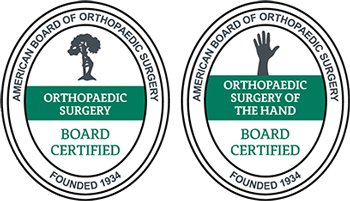Hand Infections
What is a hand infection?
Hands and the structures within are especially prone to infections, whether bacterial, viral, or fungal. The anatomy of the hand is complex, and a seemingly minor injury can cause a disproportionate amount of harm. The extremities in general have a less robust blood supply than the structures of the trunk and as a result, wounds of the extremities heal slower. Those with chronic illness, such as diabetes, or those who are immunocompromised, or abuse IV drugs are even more prone to aggressive infections in the hands.
One common type of infection of the hand is a felon. A felon is an abscess of the pulp of the fingertip. The cushiony pulp of the fingertip contains multiple small spaces called septae. Infection in these spaces can cause a buildup of fluid and pressure which can potentially decrease blood supply to the fingertip with disastrous results. Rarely, a felon can lead to infection of the underlying bone.
A Herpetic Whitlow is a painful cluster of blisters on the finger related to exposure to the herpes viruses.
Pyogenic flexor tenosynovitis is an infection of the tendon sheath that surrounds the flexor tendons of the hand.
Cellulitis is an infection of the soft tissue of the skin of the hand. The hand also contains areas of open space within it where there is no muscle, tendon, or bone. These spaces can become infected and filled with pus and are known as deep space infections.
Septic arthritis infects the joints of the hand while osteomyelitis is an infection of the bones of the hand.
What causes a hand infection?
A Felon usually results from penetrating trauma to the fingertip or from an infection of the fingernail left untreated. Herpetic Whitlow is caused by exposure to one of the numerous herpes viruses. Potential methods of transmission include exposure of a health care worker to an infected patient, exposure to a sexual partner with genital herpes, or caregiver exposure to a child with gingivastomatitis, a common viral infection of early childhood whose symptoms include blisters in the mouth.
Pyogenic flexor tenosynovitis, deep space infections, septic arthritis of the hand joints, and osteomyelitis of the hand bones share common causes. They can result from hand trauma that disrupts the integrity of the skin and introduces bacteria into the hand. A superficial wound such as an ulcer or laceration can progress to cellulitis and then spread to tendons, deep spaces, joints and bones in the hand. Bacterial, viral, and fungal infections which have spread into the circulatory system from remote areas can seed the tendons, deep spaces, joints and bones of the hand with organisms that cause infection.

What are the symptoms of a hand infection?
A Felon presents with throbbing pain in the hand, redness and swelling of the fingertip, and a feeling of increased pressure in the finger pad. Herpetic whitlow begins with a prodrome of pain, itching, redness and swelling of one finger, followed by the appearance of vesicles filled with clear fluid. Pyogenic flexor tenosynovitis symptoms include fever, swelling of the hand, and pain with passive extension of the finger. Deep space infection symptoms include fever, pain, swelling, edema and sometimes fluctuance of the affected area. Septic arthritis of the hand presents with low grade fevers, pain, and decreased range of motion of the affected joint. Osteomyelitis of the hand is a serious condition and presents dramatically with high fevers, chills, severe pain. Redness, swelling, and tenderness over the tissues surrounding the affected area of the bone also occurs.
How is a hand infection diagnosed?
The diagnosis of a hand infection is often a clinical one. The symptoms described above paired with a means to introduce infection into the hand will shed light on the cause of the hand infection. Blood tests such as a CBC may show an increase in white blood cells. Another blood test, the sed rate, may be elevated. Cultures are important to determine which organism is causing the infection and to guide appropriate antimicrobial therapy. If purulent drainage is encountered, as in a felon, cellulitis, or sometimes in a deep space infection, it should be cultured. Joint aspirate can be cultured in septic arthritis, the fluid contained in a herpetic vesicle can be cultured for virus. Aspiration and culture of the synovial fluid in pyogenic flexor tenosynovitis will also be helpful.
Imaging studies are helpful in diagnosis as well. While plain film X rays can be used as a screening tool to indicate whether bony abnormalities are present, they can also point out associated conditions which complicate hand infections such as fractures and foreign bodies. MRI is a better tool for evaluation of soft tissue abscesses and deep space infection. Bone scans and CT scans are useful for osteomyelitis.
How is a hand infection treated?
Non-surgical
Treatment of a hand infection requires identification of the offending organism. Cultures are taken but require several days for definitive results. In the interim antimicrobial therapy is started based on the most likely causative organism. This may involve antibiotics, antiviral medications, or antifungal medications. The medication may be administered orally or through an IV. Once the culture results are obtained, the medication can be tailored to the specific pathogen. A Tetanus booster is also given if one has not been given in the past year. With herpetic whitlow, oral antiviral medication is prescribed to decrease the risk of recurrence and the wound is covered to prevent further transmission of the disease.
Surgical
Abscesses require incision and drainage by a hand surgeon. Deep wounds require surgical exploration. Debridement of damaged tissue and irrigation to remove purulent material is also performed. Sometimes the wound is left open for continuous irrigation before being loosely closed later.
Arthrotomy, irrigation, and debridement are used to treat septic arthritis.
In Osteomyelitis surgical debridement of the affected bone is performed. Once the infection has been cured, another surgery to reconstruct the damaged bone may be needed.
Following surgical treatment of a hand infection, the hand is placed in a splint and elevated. Physical therapy is prescribed once the infection has healed and helps the hand regain its original range of motion.
How can Dr. Knight help you with Hand infections?
Infections are among the more serious problems that can affect your hand, and it is important to have them seen and treated as soon as possible. Generally, infections will most likely be treated in an Emergency Room rather than by a specialist, but it is still important to Dr. Knight that everyone be educated about any problems they may have with their hand, should they need to seek medical attention.
We looking forward to helping you live a more pain free life. Dr. Knight is one of the top hand doctors in Dallas. Visit Dr. John Knight at our Southlake hand and wrist center or Dallas office location.
Hand Infections Fact Sheet
| What are some common causes of hand infections? | Infections of the hand can be the result of a post-surgical infection, human or animal bites, an untreated wound, or any other wound that could make it easier for bacteria to enter the internal tissue and become infected. |
| What types of hand infections are there? | Hands are susceptible to many forms of infection. These include cellulitis, infections tenosynovitis, paronychia, felons, MRSA, deep space infections and bite wound infections. All of these infections have distinct causes and methodologies, and must be treated differently. |
| Why are bite wounds so easily infected? | Bite wounds are easily infected because the mouth is full of bacteria, humans even more so than most animals, and if you suffer from one you must wash and clean the wound immediately. Often, intense cleansing and evren surgical debridement of a bit wound may be necessary to ensure that none of the virulent mouth bacteria take hold in the wound and cause an infection. |
| Is a paronychia the same thing as a hangnail? | Technically, no. A hangnail is when the removal ofall or part of a fingernail leaves an open wound at the base of the nail, but the subsequent infection very often is a paronychia. The swelling and redness that usually follow a hangnail are hallmarks of this type of infection, and can be avoided with thorough washing and care, but often something as simple as a hangnail doesn't seem to serious until the infection has already set in. |
| What is MRSA? | MRSA is the medical acronym for Methicillin Resistant Staphylococcus Aureus, and it is one of the most dangerous infections that doctors have to content with. Most times, this type of infection is found in places like hospitals and nursing homes, but it is not unheard of to find breakouts in gyms, schools, or daycare; anywhere lots of people with untreated infections are in close quarters. MRSA must be treated aggressively, and even extirpating it will not guarantee that the bacteria can't come back again in the future. |
Frequently Asked Questions:
Is Cellulitis the same thing as an infection?
Yes. Cellulitis is the term for a specific kind of bacterial infection of the skin. Typically, it is most common on the lower body and legs, but it can also occur on the hands and arms. It is typified by red color, sensitivity to touch, and heat when touched. There can also be blistering or dimpling of the skin at and around the infection site. It is important to have cellulitis examined by a doctor as soon as possible to avoid any further development of the condition, as the responsible bacteria can multiply incredibly rapidly and spread across the skin at an alarming rate. If the cellulitis is accompanied by a fever, then the bacterial infection may have become systemic, or spread to other parts of the body, and this means that you waited too long for treatment and should see a doctor as quickly as humanly possible. While everyone carries soem risk of developing cellulitis, if you have a weakened immune system from an underlying condition or if you have an open wound, the likelihood of infection is far more likely.
What can happen to me if I get MRSA?
MRSA is the medical acronym for Methicillin Resistant Staphylococcus Aureus, and it is one of the most virulent and harmful bacteria known to medical science. Staphylococcus is a bacterium that lives naturally on our skin and on our bodies, particularly in our noses, and in a normal context, it is no more dangerous to us than any of the other thousands of bacteria that inhabit our skin. Once it enters the body itself, either through a cut or a wound or an internal injury, it can enter the blood stream or the lungs or any other organs, and cause significant damage once it gets there. Typically, staph can be treated with antibiotics with no problem, but MRSA is essentially immune to the antibiotics used to treat it, and so can run rampant while doctors search for a drug that works against it. There are many strains of MRSA, and some are more resistant than others, while some are vulnerable to other antibiotics, but it takes time to determine which kind is infecting you, and time means damage. MRSA infections often present as boils on the skin and must be drained and cleaned thoroughly to avoid further infection.
Is Paronychia very serious?
Paronychia is the infection of the skin and tissue around the fingernail or toenail, and there are two different kinds, acute and chronic. Acute is the most common, and is easily treatable, as it causes small but discrete sacs of pus to develop around the wound site. These are often the result of a hangnail or a vigorous cleaning, and so can be remedied relatively easily with careful cleaning of the wound and disinfection. Chronic paronychia is more serious, and can recur regularly. This can be cause by bacteria or fungus, and depending on the cause, can develop differently. Fungal paronychia tends to develop slowly, taking time to mature and reveal the extent of its damage to the finger. Bacterial paronychia can be very fast moving and go from mild to serious overnight.
Can I get athlete’s foot on my hand?
Athlete’s foot is called Tinea Pedis, and the ped part means foot, but there is a version called Tinea Manuum that is found on the hands. Like athlete’s foot, it is typified by an itchy rash, often accompanied with red rings (depending on the source of infection), and blisters. If left untreated, the rash may discolor the skin permanently, so early treatment is highly recommended. Often, tinea manuum is mistaken for dermatitis or psoriasis of the hands, and while they appear similar, they need to be treated differently, so it is important to ascertain which of these conditions you suffer from to properly treat it.
Animated Videos
(817) 382-6789
Disclaimer
HandAndWristInstitute.com does not offer medical advice. The information presented here is offered for informational purposes only. Read Disclaimer

























